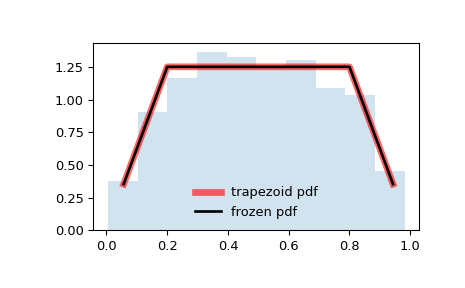scipy.stats.trapezoid#
- scipy.stats.trapezoid = <scipy.stats._continuous_distns.trapezoid_gen object>[source]#
A trapezoidal continuous random variable.
As an instance of the
rv_continuousclass,trapezoidobject inherits from it a collection of generic methods (see below for the full list), and completes them with details specific for this particular distribution.Notes
The trapezoidal distribution can be represented with an up-sloping line from
locto(loc + c*scale), then constant to(loc + d*scale)and then downsloping from(loc + d*scale)to(loc+scale). This defines the trapezoid base fromlocto(loc+scale)and the flat top fromctodproportional to the position along the base with0 <= c <= d <= 1. Whenc=d, this is equivalent totriangwith the same values for loc, scale and c. The method of [1] is used for computing moments.trapezoidtakes \(c\) and \(d\) as shape parameters.The probability density above is defined in the “standardized” form. To shift and/or scale the distribution use the
locandscaleparameters. Specifically,trapezoid.pdf(x, c, d, loc, scale)is identically equivalent totrapezoid.pdf(y, c, d) / scalewithy = (x - loc) / scale. Note that shifting the location of a distribution does not make it a “noncentral” distribution; noncentral generalizations of some distributions are available in separate classes.The standard form is in the range [0, 1] with c the mode. The location parameter shifts the start to loc. The scale parameter changes the width from 1 to scale.
References
- 1
Kacker, R.N. and Lawrence, J.F. (2007). Trapezoidal and triangular distributions for Type B evaluation of standard uncertainty. Metrologia 44, 117-127. DOI:10.1088/0026-1394/44/2/003
Examples
>>> from scipy.stats import trapezoid >>> import matplotlib.pyplot as plt >>> fig, ax = plt.subplots(1, 1)
Calculate the first four moments:
>>> c, d = 0.2, 0.8 >>> mean, var, skew, kurt = trapezoid.stats(c, d, moments='mvsk')
Display the probability density function (
pdf):>>> x = np.linspace(trapezoid.ppf(0.01, c, d), ... trapezoid.ppf(0.99, c, d), 100) >>> ax.plot(x, trapezoid.pdf(x, c, d), ... 'r-', lw=5, alpha=0.6, label='trapezoid pdf')
Alternatively, the distribution object can be called (as a function) to fix the shape, location and scale parameters. This returns a “frozen” RV object holding the given parameters fixed.
Freeze the distribution and display the frozen
pdf:>>> rv = trapezoid(c, d) >>> ax.plot(x, rv.pdf(x), 'k-', lw=2, label='frozen pdf')
Check accuracy of
cdfandppf:>>> vals = trapezoid.ppf([0.001, 0.5, 0.999], c, d) >>> np.allclose([0.001, 0.5, 0.999], trapezoid.cdf(vals, c, d)) True
Generate random numbers:
>>> r = trapezoid.rvs(c, d, size=1000)
And compare the histogram:
>>> ax.hist(r, density=True, histtype='stepfilled', alpha=0.2) >>> ax.legend(loc='best', frameon=False) >>> plt.show()

Methods
rvs(c, d, loc=0, scale=1, size=1, random_state=None)
Random variates.
pdf(x, c, d, loc=0, scale=1)
Probability density function.
logpdf(x, c, d, loc=0, scale=1)
Log of the probability density function.
cdf(x, c, d, loc=0, scale=1)
Cumulative distribution function.
logcdf(x, c, d, loc=0, scale=1)
Log of the cumulative distribution function.
sf(x, c, d, loc=0, scale=1)
Survival function (also defined as
1 - cdf, but sf is sometimes more accurate).logsf(x, c, d, loc=0, scale=1)
Log of the survival function.
ppf(q, c, d, loc=0, scale=1)
Percent point function (inverse of
cdf— percentiles).isf(q, c, d, loc=0, scale=1)
Inverse survival function (inverse of
sf).moment(order, c, d, loc=0, scale=1)
Non-central moment of the specified order.
stats(c, d, loc=0, scale=1, moments=’mv’)
Mean(‘m’), variance(‘v’), skew(‘s’), and/or kurtosis(‘k’).
entropy(c, d, loc=0, scale=1)
(Differential) entropy of the RV.
fit(data)
Parameter estimates for generic data. See scipy.stats.rv_continuous.fit for detailed documentation of the keyword arguments.
expect(func, args=(c, d), loc=0, scale=1, lb=None, ub=None, conditional=False, **kwds)
Expected value of a function (of one argument) with respect to the distribution.
median(c, d, loc=0, scale=1)
Median of the distribution.
mean(c, d, loc=0, scale=1)
Mean of the distribution.
var(c, d, loc=0, scale=1)
Variance of the distribution.
std(c, d, loc=0, scale=1)
Standard deviation of the distribution.
interval(confidence, c, d, loc=0, scale=1)
Confidence interval with equal areas around the median.